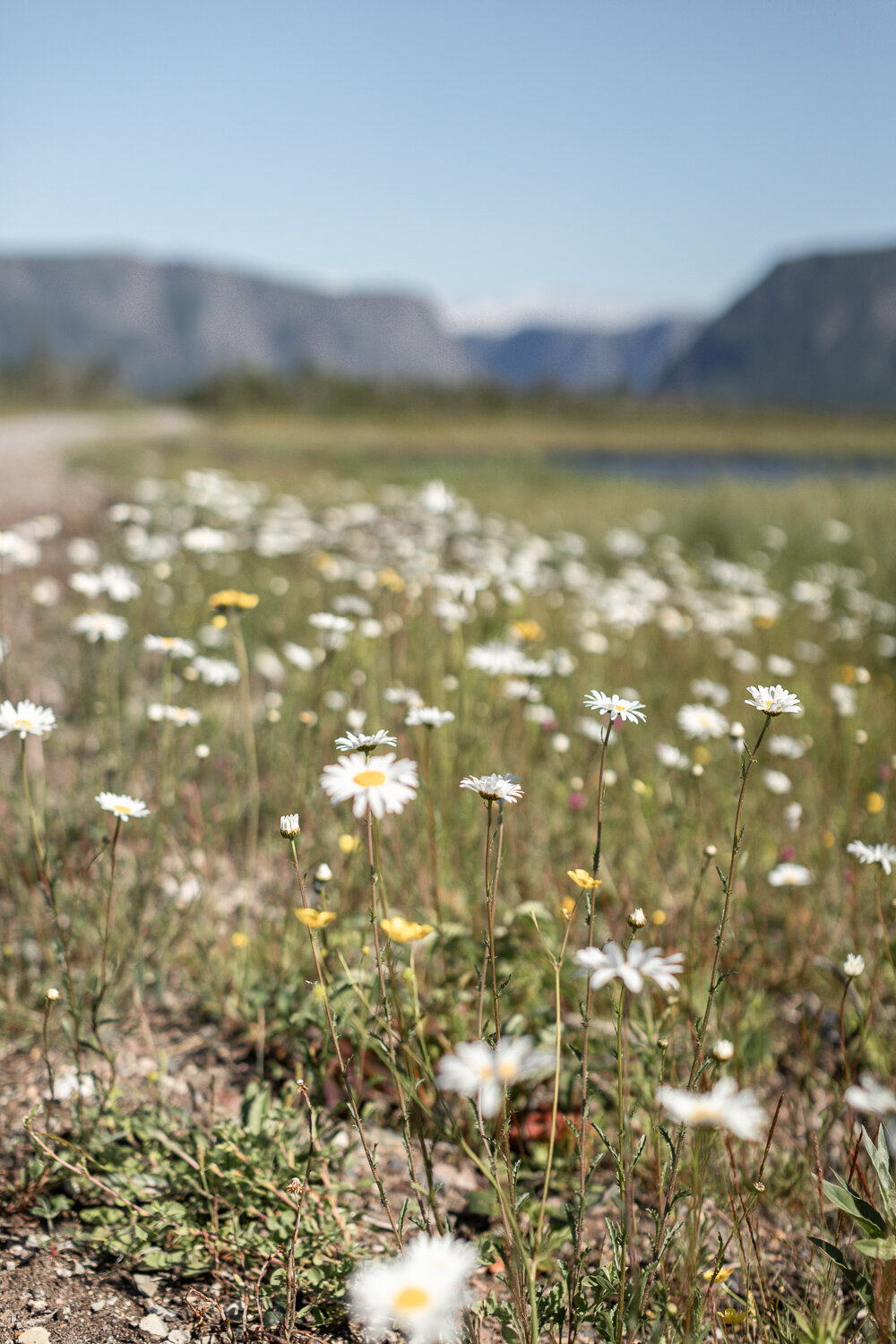Hiking and Vikings: A Must-Do Newfoundland Road Trip Itinerary Along the Viking Trail
/Newfoundland’s Viking Trail
From Gros Morne to L’anse aux Meadows
*This post contains affiliate links, meaning I may make a referral fee if you purchase a product or service through my link. I only make recommendations when I truly LOVE something, and it won’t cost you a LOONIE more. Thank you for helping to keep this little blog afloat.
There are some places that are close enough to my home that I continuously wonder how I haven’t visited them yet. It seems they make my to-do list seasonally every year, and yet I never seem to tick them off. One of those places for me, until quite recently, was Newfoundland!
I’ve been eager to photograph Newfoundland in all of its scenic, natural glory for some time. In specific, as I LOVE to seek out road trips, I’ve been eager to drive Newfoundland’s Viking Trail that runs along the West Coast of the province. To hike in the quiet, barely touched scenery of Gros Morne National Park and walk where the Vikings walked centuries ago in L’anse aux meadows. And maybe, just maybe, if I was lucky enough, spot an iceberg off the coast of St Anthony.
So this summer we set out to do just that, and I was so pleased with the sites we chose to visit that I can’t wait to share them with you. So, let’s get started!
Quick tips for visiting Western Newfoundland
Hike in the wilderness of Gros Morne National Park
Visit a landlocked Canadian fjord
Walk where the Vikings once roamed at L’anse aux Meadows
Search for icebergs in St Anthony
Eat fish and chips and discover why Newfoundland is famous for cod
Drink Iceberg beer by Quidi Vidi Brewery
Spot a moose or caribou in its natural habitat
When to visit Western Newfoundland
Iceberg season starts in May, and can occasionally extend into early July. Winters can be harsh. May through September is best for hiking.
Getting to Western Newfoundland
If travelling up from the Canadian Maritimes, you can arrive in Port aux Basques by ferry from North Sydney, then drive north until you reach Deer Lake, the start of the Viking Trail. There is also an airport in Deer Lake.
Where to stay along the Viking Trail
We stayed at the brand new, well-appointed Fish Sheds in Rocky Harbour. These cottages could not be in a better location. They are on the waterfront, situated on a stunning cliff’s edge, in Gros Morne National Park and are central to all the activities and hiking trails in the area. I highly recommend staying here.
Things to do on the West Coast of Newfoundland
Hike in Gros Morne National Park
Perhaps the most popular vacation spot in Western Newfoundland, Gros Morne National Park is a hiker’s dream. Trails cut through wilderness of varied ecosystems. From meandering along shorelines, to mountain climbing, to walking on the mantle of the earth, the park has it all.
Western Brook Pond
Fjords. They’re only found in Scandinavia, right? Where waterfalls rush down from tall steep-sided cliffs, and mythical stories of trolls and ice queens abound? Not so.
Fjords are carved out tunnels from ancient receded glaciers. As a glacier disappears, it leaves behind an inlet that traditionally fills with sea water. As such, Northern Canada is a fantastic place to find a fjord, and in Newfoundland, the most iconic one is Western Brook Pond.
Western Brook Pond is unique as a fjord that does not reach the sea. It is landlocked and filled with fresh water.
You can tour Western Brook Pond by boat, go on a guided day hike up to a stunning view point, or take on a multi-day hike and back-country camping expedition along the Long Range Traverse.
Gros Morne Mountain
Here’s a bucket list item for you. Every local in the area will ask you if you plan to complete one hike… the summit of Gros Morne Mountain.
I would be lying if I said this is a simple hike, or that it isn’t at all intimidating. If you choose to hike Gros Morne Mountain you’ll understand where I’m coming from when you reach the base of the gully.
Let’s rewind.
The hike is advertised to take 6-8 hours to complete. It took us 7 hours. It begins as a peaceful hike through the wilderness, past bogs (look out for moose!) and through the woods, while maintaining a steady incline for a good 1.5 hours.
At the end of this hike, you reach a lookout at the base of a massive gully, cut into the side of the mountain, filled with many, many boulders. Photos don’t do it justice. It is a steep climb upward. At times, we had to use our arms to pull ourselves upward against the rocks. The good news is, it’s not all like this. And it’s absolutely achievable if you take your time. Find shade. Take breaks. Have a snack and some water.
Once you reach the top of the gully, you have an easy walk to the summit.
The walk home is typically completed by heading down around the back side of the mountain and circling around until you reach the lookout at the base.
It’s a strenuous day. Bring lots of water - at least 2 litres per person. Wear good shoes and dress in layers. It can be windy at the summit. Previous hikers have built rock shelters around the summit to break the wind. If I can do it, you can do it. Trust me.
Tablelands Trail
Now for something entirely different…
In stark contrast to the lush marshlands and woods of the last two trails, the Tablelands, in the southern end of the park, is dry and arid. It’s an intriguing hike with geological significance.
Essentially, in this part of the park, collision of the earth’s plates have raised the mantle to the surface. Where else can you walk on the mantle of the earth?
The hike can be as easy or difficult as you would like to make it. It’s an easy, slow climb to the viewpoint you see below and hiking straight in and back only takes about an hour. However, you can make your own path beyond this point, even climbing to the top of the ledges if you wish. Bring water and fly repellant.
Green Gardens Trail
The Green Gardens Trail has to be one of my favourite hikes in Gros Morne. It is inconspicuously located just down the road from the Tablelands Trail, in the south of the park. From the road, it appears as a hike up a barren hillside over boulders on uneven ground. Unassuming. However, once you reach the top of the hill, you head into the woods and begin to descend toward the coastline.
That’s where the magic is. The coastline in this region is stunning. Vibrant green vegetation covers the cliffs that drop off into the ocean. The banks are covered in meadows, where it is common to see wild sheep grazing, leftovers from farms of the past.
I highly recommend checking this one out! Give yourself a half day to complete the hike. We were 4 hours. You can make this hike longer by continuing along the coastline once you reach the first viewpoint, searching for lambs along your way.
Lobster Cove Head Lighthouse
A quick and easy stop, that is infinitely more unique than it appears, Lobster Cove Lighthouse sits on a point looking over Rocky Harbour. You can get fantastic photos of town from the parking lot and trails surrounding the light. What’s even more interesting is the design of these trails.
If you start by entering the trail to the left of the parking lot, rather than heading straight for the point, you’ll find yourself wandering through a maze of short, tuckamore tree canopies (short, coniferous trees native to Newfoundland). It is like walking through a fairytale.
Once you’ve finished hiking the park, head north along the Viking trail. Take note of the small fishing towns you pass, and the strange shape of the tuckamores, permanently growing with a lean from the winds.
Pro tip: Fill your car with gas in the park and bring snacks. Amenities are few and far between on this drive. The drive from Gros Morne to St Anthony takes around 3.5 hours.
Swing by Arches Provincial Park
I recommend making a quick pit stop at Arches Provincial Park and viewing the power of erosion on the limestone coastline. It’s an excellent place for a picnic and a stretch.
Stop by the village of Port aux Choix
Port aux Choix is a well established fishing community with a rich history. Ancient burial sites from centuries ago have been discovered here. As such, it has been named a National Historic Site.
Take a drive through town and visit Point Riche Lighthouse for striking views and maybe even a wildlife sighting or two.
Search for Icebergs in St Anthony
When you reach St Anthony, you’ll discover a couple of things. Firstly, the people here are so incredibly sweet and helpful. Secondly, you’re at the beginning on Newfoundland’s portion of “Iceberg Alley”, where the currents sweep icebergs along the Northern shore of the island.
The iceberg we discovered below was seen in Goose Cove, just outside of town. There were four in total on this day.
Consider an iceberg tour in the area from St Anthony to L’anse aux Meadows. A popular place to take these tours is Quirpon, an island to the extreme North of the Great Northern Peninsula.
Explore the Arctic Conditions of Burnt Cape Ecological Reserve
Occasionally we stumble upon something we weren’t aware existed, and often those places provide the most interesting experiences of our trips. Burnt Cape Ecological Reserve was one of those places.
This nature reserve is located just outside of the town of Raleigh, a short, 20 minute drive from St Anthony. It is unique in that it is an example of arctic tundra in Newfoundland.
On the surface, it appears completely barren, but if you look closely, there are unique arctic plants growing all over. Species that don’t typically grow in the area, and therefore, must be protected.
Visit the Viking settlement at L’anse aux Meadows
Finally, at the end of the Viking trail, you will arrive in the only Viking settlement in Canada, L’anse aux Meadows. This area has easily earned UNESCO World Heritage Site status. You can explore the re-creation of the Viking village and see the remnants of the real village, uncovered by archeologists.
The re-created buildings are composed of peat moss, mud and grasses. Doorways are short. It’s hard to picture living in this way. Simply amazing.
The coastline surrounding the Viking settlement is gorgeous and picturesque.
Bonus! Watch for wildlife all along the way…
I hope you have enjoyed this Western Newfoundland road trip itinerary. If you have any suggestions for additions, please submit them in the comments!
An excellent addition to this itinerary is the Cabot Trail in Cape Breton, Nova Scotia. You can easily explore this area after returning from Western Newfoundland by ferry to North Sydney.
Until next time!
Hill XO
If you found this post helpful to you, Pin it!
























